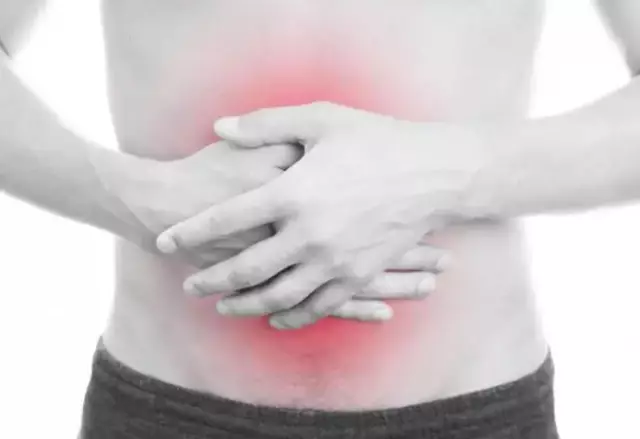- Author Rachel Wainwright [email protected].
- Public 2023-12-15 07:39.
- Last modified 2025-11-02 20:14.
Sharp belly

Acute abdomen is a clinical syndrome that develops in acute diseases and injuries of the abdominal cavity and retroperitoneal space, which require or may require emergency surgery. An acute abdomen is usually accompanied by abdominal pain of varying intensity and character, tension of the abdominal wall muscles, and impaired intestinal motility. Pseudo-abdominal syndrome can mimic the clinical picture of this condition. In pseudo-abdominal syndrome, acute abdominal pain is caused by diseases of organs located in the abdominal cavity or outside the abdominal cavity (colitis, gastritis, pyelonephritis, acute pneumonia, myocardial infarction). These diseases are accompanied by a number of symptoms of an acute abdomen, but they are subject to conservative treatment.
The main reasons for the development of an acute abdomen
Acute abdominal pain can occur in acute nonspecific inflammatory diseases of the digestive system (pancreas, gallbladder, vermiform appendix). The development of an acute abdomen may be due to perforation of any organ. Perforations usually occur as a result of various inflammatory processes or damage to organs located in the abdominal cavity.
Acute pain in the lower abdomen may be associated with internal bleeding into the retroperitoneal space and abdominal cavity (for example, with a rupture of the fallopian tube during an ectopic pregnancy or with an aneurysm of the abdominal aorta). Traumatic ruptures of the spleen, mesenteric vessels and liver can also be accompanied by the development of an acute abdomen.
Sudden sharp pain in the abdomen can occur with intestinal obstruction. Intestinal obstruction can develop with nodulation, volvulus, entrapment of the intestine in an external or internal hernia, intussusception, obstruction.
The main symptoms of an acute abdomen
The main symptom of an acute abdomen is pain that is localized and spreads throughout the abdomen. In severe and extensive lesions, a pronounced pain syndrome may be accompanied by the development of pain shock. Pain is insignificant in acute abdominal syndrome in young children, in emaciated patients.
Vomiting is a common symptom of an acute abdomen. It can occur in the first minutes or hours of the disease. With irritation of the phrenic nerve, sometimes persistent painful hiccups appear, pain when pressing between the legs of the sternocleidomastoid muscle. This condition is often accompanied by a violation of the passage of intestinal contents. Gas and stool retention may be associated with dynamic or mechanical bowel obstruction. An important symptom of an acute abdomen is a change in the nature of feces. An admixture of blood in the feces can be observed in acute disorders of the mesenteric circulation.
With diffuse peritonitis, massive bleeding into the abdominal cavity, a sharp pallor of the mucous membranes and skin is usually observed. For advanced, severe forms of diseases that occur with the clinical picture of an acute abdomen, the patient's indifferent expression, sunken eyes, drawn cheeks, gray skin color are characteristic. Intraperitoneal bleeding is usually accompanied by severe tachycardia and a decrease in blood pressure (up to the development of collapse).
Reasons for the development of an acute abdomen in children
Acute abdomen in children most often develops as a result of intestinal obstruction and acute appendicitis.
Acute abdominal pain is the main symptom of appendicitis. The child becomes lethargic, capricious, does not sleep well. Appendicitis is often accompanied by the appearance of loose stools with mucus, which is why this disease is often confused with an intestinal infection or poisoning. At the onset of the disease, pain is localized not in the right iliac region, but in the upper abdomen or in the umbilical region. The development of the disease is not always accompanied by nausea, vomiting, and fever.
With the development of intestinal obstruction, the child screams, vomiting appears, there is no stool, and gases do not go away. The child's condition deteriorates sharply. In children aged from six months to one year, intestinal obstruction is often caused by intestinal intussusception. Intestinal intussusception can be caused by inappropriate feeding (excess of fruits and vegetables). With an acute abdomen associated with intestinal obstruction, vomiting with an admixture of bile or with intestinal contents may appear. In this case, instead of feces, blood with mucus comes out of the rectum.
For acute abdominal pain, pain medications should not be given to the child until a doctor is examined. Until the cause of the pain is determined, the child should not be fed.
If acute pain in the abdomen does not stop within an hour, then you should immediately call for medical help.
Sharp abdomen in gynecology
An acute abdomen in gynecology is a complex of symptoms caused by various pathologies of the abdominal organs (small pelvis). A sharp pain in the lower abdomen is the main symptom of an acute abdomen in gynecology (paroxysmal or constant, of a different nature - stabbing, cutting). Vomiting, dizziness, weakness, bleeding, hiccups may occur. Acute pain in the lower abdomen can be accompanied by pressure on the anus and problems with stool.

The most common cause of acute abdomen development in gynecology is ectopic pregnancy (more than 48% of cases). Acute pain in the lower abdomen can appear with acute inflammation of the ovaries and ovarian apoplexy.
The cause of an acute abdomen can be traumatic injuries and impaired blood circulation in the tissues of the uterus, as well as acute inflammatory processes of the internal genital organs (acute adnexitis, torsion of the cyst pedicle or ovarian tumor, necrosis of the myoma node of the uterus).
This syndrome can appear after operations on the uterus and appendages, after abortions, as well as against the background of infectious diseases in an advanced form.
YouTube video related to the article:
The information is generalized and provided for informational purposes only. At the first sign of illness, see your doctor. Self-medication is hazardous to health!






